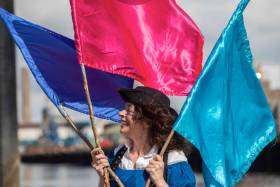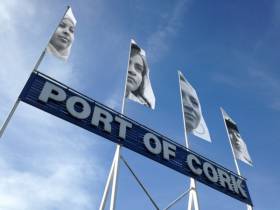Displaying items by tag: Cork Harbour Festival
The much-anticipated Cork Harbour Festival is returning this June for 10 days of maritime fun, running from the 1st to the 10th. The festival showcases Cork's stunning natural assets, including Cork Harbour and the River Lee, and promises a diverse programme of events across both Cork City and County.
One of the festival's main attractions is Ocean to City - An Rás Mór, a long-distance coastal rowing race that draws participants from around the world. This flagship event will take place on Saturday 8th June, offering spectators an exciting display of skill and endurance.
With over 80 events spread across a dozen beautiful locations, including Myrtleville, Cobh, Crosshaven, and Spike Island, the festival caters to a wide range of interests and age groups. From water sports and boat tours to heritage walks and cultural experiences, there's something for everyone to enjoy.
Geri Murphy, the Festival Manager, expressed her excitement, stating, "Meitheal Mara are delighted to bring you yet another amazing fun-filled programme of events for this year's Cork Harbour Festival, now in its 10th year. We can't wait to welcome thousands of visitors to come and delve into all the Maritime fun that this Festival has to offer, and explore the awe and beauty of Cork this June."
The festival has garnered support from various sponsors, including Cork City Council and Cork County Council. Lord Mayor of Cork City, Councillor Kieran McCarthy, emphasised the festival's role in showcasing the city's maritime stories and promoting a healthy lifestyle.
On the 8th of June, Ocean to City - An Rás Mór will see hundreds of rowers and paddlers compete in a challenging 28km race through the harbour, offering spectators ample vantage points to witness the action.
Mayor of the County of Cork, Cllr. Frank O'Flynn, underlined the festival's celebration of Cork's maritime heritage and its potential as a world-class visitor destination.
With its rich program of events and activities, the Cork Harbour Festival promises an unforgettable experience for both locals and tourists, celebrating the beauty and history of this remarkable region.
2024 Cork Harbour Festival Programme:
On the Water:
We have a huge amount of water activities happening during Cork Harbour Festival. Embark on an exhilarating 3-hour tour of Cork Harbour with Ocean Escapes (9th June). Enjoy an exciting 2 hour Evening Rib Tour of Cork Harbour with Cork Harbour Boat Hire (1st & 7th June) or explore the Wildlife & Coast of Cork Harbour with Cork Sea Safari (1st, 2nd, 8th & 9th). Take an introductory lesson in scuba diving with Cork Scuba and Freediving Centre (3rd – 7th). Try surfing and coasteering with Swell Surf School (1st June). Give kayaking a go with Phoenix Kayak Club (7th) or kayak under the bridges of Cork and see the city like you never have before with Atlantic Sea Kayaking (9th June). Hop into a dragon boat with the Cork Dragons (1st June) in the city or head to East Ferry to try yacht sailing with SailCork (1st & 4th June). If you’d rather keep your feet on stable ground head out to support all the participants in the Ocean to City Race (8th June), the Myrtleville to Church Bay 2km Open Water (10th June) and the Rebel Plunge (16th June).
Family Events:
Learn how to read a map and navigate with your family while exploring Cruachain Woods and Crosshaven town with Bishopstown Orienteering & Hillwalking Clubs (2nd June) and explore how to navigate the stars at the MTU Blackrock castle Observatory (8th June). The ever popular Cork Ghost Tour is back this year for more hilarious frights and hysterical delights for all the family (6th & 7th June). Head to Cobh for live music, a market and lots of family fun at Cobh Summer swing (9th June) or create a LEGO masterpiece with Brickxclub in Crosshaven (2nd June). Check out all the winning model boats from the Lord Mayor Kieran McCarthy’s Make a Model Boat Project at Cork City Library (2nd- 22nd June) and then go play at the Currach Olympics on dry land at Marina Park (9th).
Education:
The popular Lunchtime Lecture series, presented by the UCC History Department returns this year, covering fascinating topics such as Farming and the growth of international trade in the south of Ireland, c. 1250-1800 (4th June), Cross-cultural connections in the early medieval Irish Sea (5th June) and The story of Kinsale Natural Gas (6th June). Learn all about bottlenose dolphins with ORCA Ireland (9th June) and about limitless swimming with Guinness World Record holder Nuala Moore (8th June). Head to Fountainstown for a shore walk and talk on the vulnerabilities of the area and how we can help to protect the coast with the Enviromental Forum or discover Maritime Careers at the National Maritime College of Ireland in Ringaskiddy (7th June).
Heritage:
Take a historical walking tour with the Lord Mayor Kieran McCarthy as he recites Stories from Blackrock and Mahon (3rd June). Head out to Belvelly Smoke House in Cobh to learn all about and taste Hedermans famous smoked fish (1st-10th bar Sundays). Discover Cork’s captivating history on a Cork City Cycle tour with Beyond the Glass Adventures (1st, 4th – 8th & 10th June). Cobh Heritage Museum, Spike Island, Titanic Experience Cobh, Camden Fort Meagher and Elizabeth Fort will also be open for visitors.
Nature:
Join Subowti and Clean Coasts to clean up the Lee on your kayak, canoe, paddleboard or on foot (9th June). Explore Cork City and County with digital Self-Guided Walking Trails with Travella or join Cork Nature Network to learn all about otters (8th June). Join ORCA Ireland for a beach clean followed by a land-based sea-life watch in Crosshaven (2nd June). Hop on your bike and join the Lee to Sea Committee (9th June) or take a Cork Harbour Greenway cycle tour with Beyond the Glass Adventures (4th - 6th & 8th June).
Arts & Culture:
Enjoy some of the visual art on display during the festival; Deep Time from the Backwater Artists Group on display on Spike Island (2nd-10th June), Ariadne’s Thread at the MTU Gallery at 46 Grand Parade (4th-10th June) and Etaoin Melville: 'Silent Voices' at Triskel Arts Centre (1st –10th June). Cobh based a-cappella buoy band The Mologoggers will perform both traditional and new sea shanties in the beautiful Goldie Chapel in Nano Nagle Place (8th June). Hear stories from the Gab (9th June) or poetry from Ó Bheál (10th June) about Cork Harbour, the Lee and the sea. Learn about Cork City and its waterways with a comedic dinner experience with Hysterical Histories (1st, 6th, 7th & 8th June).
See the full festival programme of events here
An exciting in-person event is to be held at the National Maritime College of Ireland (NMCI), with tours of the campus in Ringaskiddy taking place on Friday, 7 June.
The free tours are part of the 10-day Cork Harbour Festival.
Explore the fascinating world of maritime education and training while enjoying the beautiful surroundings of Cork Harbour from where the festival takes place between 1-10 June.
So don't miss out on this unique opportunity to learn about the maritime industry and experience the NMCI first-hand as the college celebrates its 20th anniversary.
The afternoon tours will be an opportunity to meet with maritime industry representatives and to learn more about maritime careers and education.
Tickets are free, but tour booking is essential, for each tour will last for 45-50 minutes approximately and can accommodate twenty people.
To join a tour, select your timeslot (at the time of writing, some tours remain unbooked) using the link below that is directed to Eventbrite.
To book your NMCI tour, select your tour time via this link.
Cork Harbour Festival is sure to make a big splash this June Bank Holiday Weekend.
And the festivities are only beginning on Saturday 1 June, with nine days celebrating all things maritime taking over Leeside and Cork Harbour — for those with their sea legs and landlubbers (or land lovers) alike.
The showcase event that draws huge crowds every year is Ocean to City – An Rás Mór.
The race is the largest of its kind in Ireland and attracts competitors from all over Europe and as far as the USA.
The 200-strong fleet will give spectators a chance to see an array of vessels from traditional wooden boats, currachs and gigs to Chinese dragon boats, kayaks and even stand-up paddleboards.
The race starts in Crosshaven at 10.30am on Saturday and there will be free family entertainment, music and food at some of the best viewing points along the race route at Cobh, Passage West, Blackrock Pier and the city centre.
If you’re feeling energetic, you can cycle alongside the fleet for part of the racecourse from Father O’Flynn Park in Passage West.
Or you can get caught in the rhythm at the Port of Cork with a 14ft drum for all to play – no experience of drumming necessary.
Take your place at the finish line at Lapp’s Quay with live race commentary from Cork’s 96FM and food stalls, street performances, balloon artists, DJs, drummers and much more to keep you entertained while you welcome the participants as they complete this spectacular race.
If you prefer to stay on dry land, you’ve so much to choose from – with Camden Fort, Elizabeth Fort and Spike Island all open for tours every day of the Bank Holiday weekend.
As the sun sets there will be some very special performances happening including the Johnny Cash Tribute on Spike Island on Saturday evening, and a swashbuckling concert performance of The Pirates of Penzance on Sunday at Cork Opera House.
Most of the festival events are family friendly, making this the ideal way to have some great waterside adventures with the kids (and the young at heart!)
There’s everything from children’s storytelling in Passage West Library to Cobh Harbour tours.
Bring your trainee pirates to the Circus Factory on Saturday for some pirate circus training, or get the whole family team working together for orienteering on Sunday and Monday with Bishopstown Orienteering Club.
Join the ‘3 For the Sea’ Beach Day in Myrtleville on Sunday, or being bidding artists to the Crawford Art Gallery on Monday for a family-friendly art workshop and tour.
But no Cork Harbour Festival would be complete without a chance to get out on the water.
SailCork in East Ferry have an open day on Bank Holiday Monday, and you can try sailing at the world-famous Royal Cork Yacht Club with free tasters on Sunday.
With a weekend packed full of water-based activities, you can brave a high-speed harbour tour, paddle, kayak, sail, surf or SUP your way through the weekend.
Get all the details of the full festival programme with over 70 events on CorkHarbourFestival.com.
#Unveiled - Unveiled Horizons/Horizons dévoilés is an artistic transmedia interactive experience that is part of the Cork Harbour Festival (3-11 June), the Cork Midsummer Festival and in partnership with the French Embassy in Ireland.
The outdoor installation which is free is sited on the city’s Custom House Quay. This Friday, 9 June, at this quay is expected a visit of the square-rigger Pelican of London.
The artistic concept develops the relation between art, digital media and social issue through an application, a participatory website and an outdoor installation questioning women’s horizons in port city around the world.
This provocative and beautiful work by French photographer Carl Cordonnier and Jools Gilson from UCC Creative, focuses on the hidden presence of women in port towns and cities.
Through interviews and photography workshops, Unveiled Horizons collaborates with women from Cork on the composition of their portraits.
To follow them in Cork where Carl and Jools met a group of inspiring women. Their Facebook page link is located on the French Embassy in Ireland website here.






























































